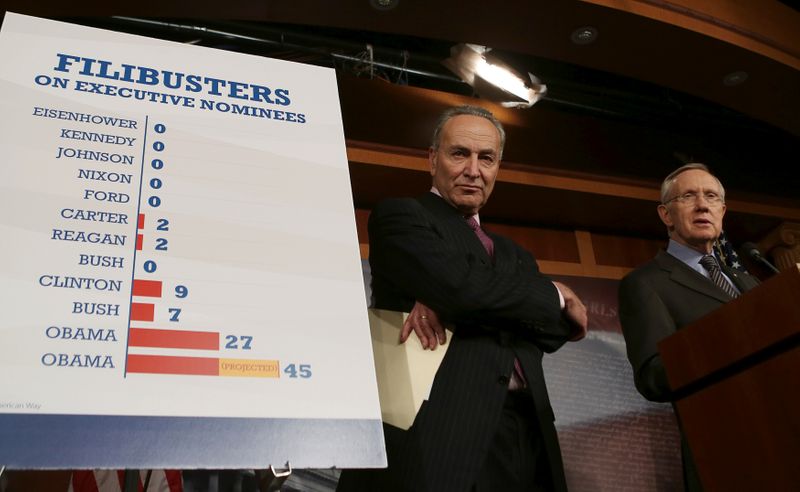WASHINGTON (Reuters) – Pressure is growing among President Joe Biden’s Democrats to end the filibuster, a long-standing Senate custom that requires a supermajority to advance most legislation in a chamber that in recent years has been closely divided and is now split 50/50 between the two parties.
As long as the filibuster exists, liberal Democrats say, Republicans in the chamber that likes to call itself “the world’s greatest deliberative body” will be able to use it to block progress on their priorities, including addressing climate change, voting rights and immigration.
WHAT IS THE FILIBUSTER?
To “filibuster” means to delay action on a bill or other issue by talking.
The Senate filibuster first captured the American imagination in Frank Capra’s 1939 movie “Mr. Smith Goes to Washington,” when Jimmy Stewart’s character spoke for more than a day, and more recently in 2013 when Texas state Senator Wendy Davis spoke for 13 hours to try to block a bill imposing new restrictions on abortion.
The popular image of a lone lawmaker mounting an impassioned hours-long argument belies the reality in today’s Senate, where a mere threat is often enough to initiate a filibuster and hold up a bill.
A filibuster can only be stopped if 60 senators vote to end debate in a process called cloture.
WHY IS THE RULE A PROBLEM FOR DEMOCRATS?
With just 50 senators, Democrats will not be able to overcome filibusters on their bills unless at least 10 Republicans vote with them.
But many Republicans are deeply skeptical of Democratic priorities and unlikely to help build supermajorities.
Democrats were able to pass Biden’s $1.9 trillion COVID-19 stimulus plan without a supermajority through another Senate maneuver called “reconciliation,” with the help of Vice President Kamala Harris’s tie-breaking 51st vote. But the rules limit the use of that process.
Senate Republicans, led by Mitch McConnell, say Democrats should work to produce bipartisan legislation instead of trying to end or change the filibuster.
Biden, who served in the Senate for 36 years, does not favor a change, according to the White House.
WHEN DID THE SENATE ADOPT THE FILIBUSTER RULE?
Although the U.S. Constitution makes no mention of filibusters, long-winded Senate speeches became an increasingly common tactic in the 19th century.
By 1917 most senators had had enough, agreeing that a vote by a two-thirds majority could end debate.
But getting two-thirds of the Senate was hard, so filibusters continued. Notoriously, they were used by southern senators who sought to block civil rights laws.
In 1975, the Senate reduced the requirement for limiting debate to three-fifths of the Senate – currently 60 senators.
In that decade, the Senate leadership began agreeing to allow measures that were facing a filibuster to be put aside while the chamber acted on other bills.
The move was intended to prevent opposition to a single bill bringing all work in the chamber to halt, but it also meant that the filibuster changed from an energy-draining maneuver involving lengthy speeches to a mere objection, or threat to object.
Over time the number of filibusters skyrocketed. There is no sure-fire way of counting how many bills are filibustered in a year because of the nebulous nature of the threats. But a count of votes to try to overcome a filibuster, the nearest reliable proxy, shows 298 such votes in the 2019-2020 legislative session. That’s up from 168 such votes in the previous two years. In 1969-1970 there were six.
Putting filibustered bills aside “made filibustering actually more successful, and even less costly, which was not intended. And it might have, paradoxically, made things worse,” said Sarah Binder, a political science professor at George Washington University who co-wrote a book on the filibuster.
CAN THE FILIBUSTER BE CHANGED?
There have already been changes, in addition to changing the number of votes required for cloture.
In 2013, Democrats removed the 60-vote threshold for voting on most nominees for administration jobs, apart from the Supreme Court, allowing them to advance on a simple majority vote.
In 2017, Republicans did the same thing for Supreme Court nominees.
Recently some centrist Democrats have joined ranks with liberals including Senator Jeff Merkley, who has long favored reforming the 60-vote threshold for legislation.
“The filibuster has long been the enemy of progress. In fact, it’s been a highly effective tool to thwart the will of the people,” Senator Tina Smith wrote on Facebook after coming to support an end to the filibuster.
The Senate’s No. 2 Democrat, Dick Durbin, suggested the party should try bringing some bills with bipartisan appeal to the floor to see if they are filibustered. If they can’t get at least 60 votes, then the caucus could talk about possible modifications to the procedure.
WHO OPPOSES CHANGE?
McConnell, for one. At the start of this year he tried but failed to get an explicit promise from his Democratic counterpart Chuck Schumer to protect the filibuster.
But at least two Senate Democrats, Joe Manchin and Kyrsten Sinema, both moderates, also do not want to ditch the 60-vote threshold. Without them, Schumer does not have the majority needed to gut the rule.
(Reporting by Susan Cornwell; Editing by Scott Malone and Sonya Hepinstall)


























